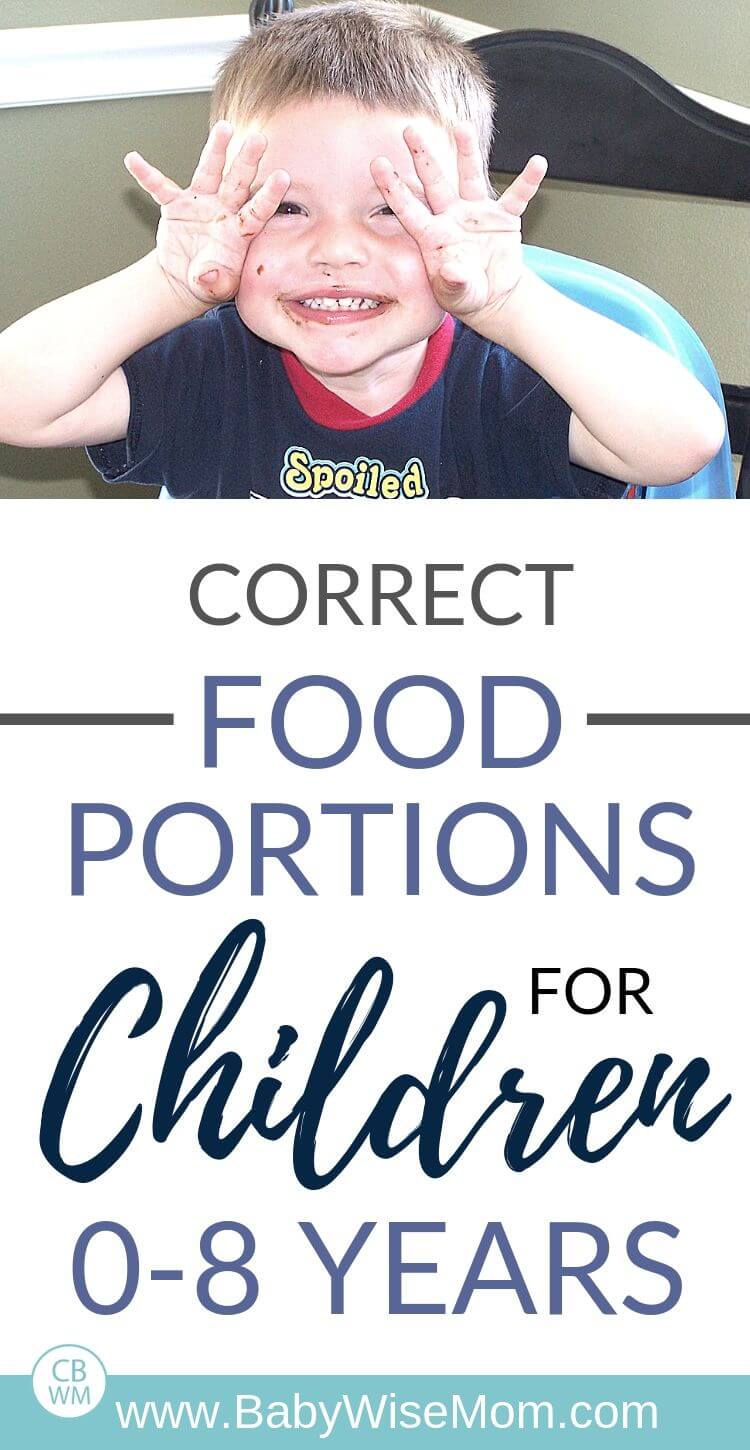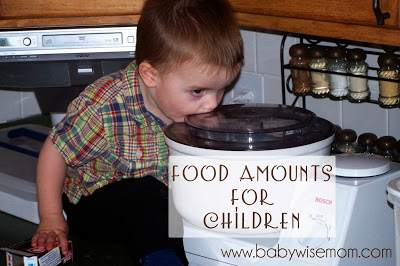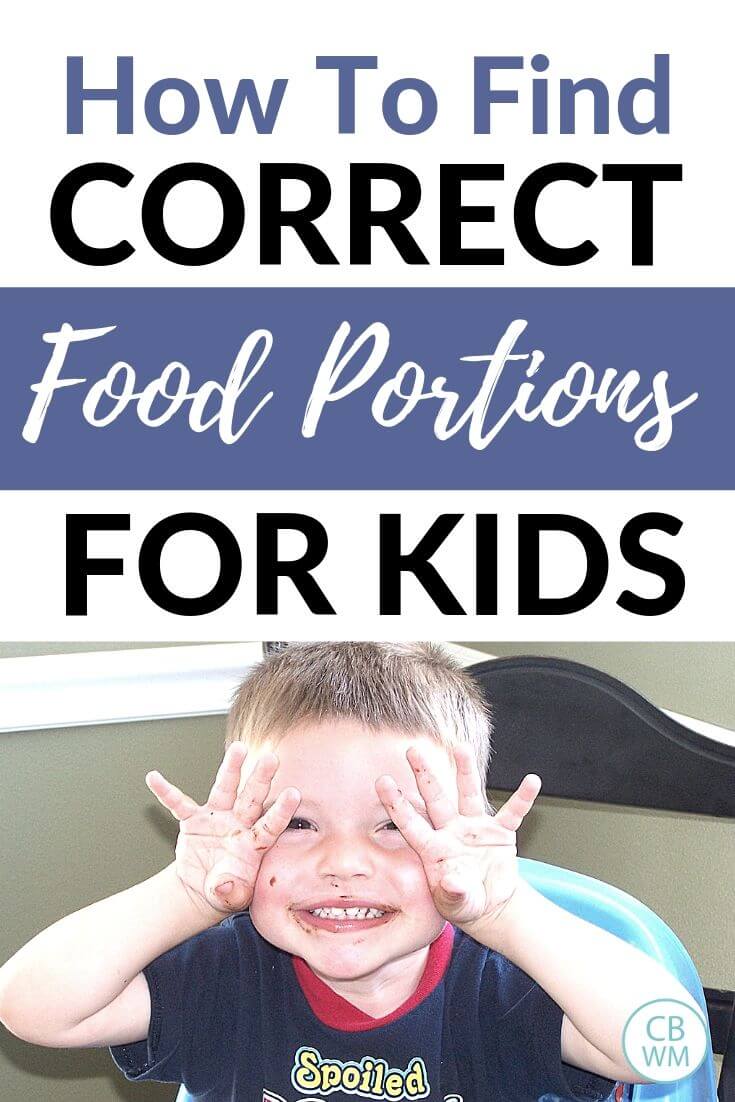Know what food portions and serving sizes you should be feeding your little one. Get recommended serving sizes by age from birth through age 8.

And it doesn’t get more stressful than when you have kids to feed. You can have a child who barely eats anything. You can have a child who has a food aversion and basically doesn’t eat at all. You can have a child who seems to be eating more than humanly possible. Is your child getting enough? Too much? How much should you offer? AAAAaaahhhhhhh!!!!!Food is a basic need in life. It seems like it is something we should be able to manage intuitively, right? We shouldn’t have to think about it so much! But it is a huge part of our day to day and such a stress in many ways.
While there are some good things to understand about food and nutrition, I personally think it is all simpler than we sometimes make it out to be. But with our own personal issues with food and body image that we bring to the table, it can be hard to step back and relax about it all.
Post Contents
A Balanced Approach on Serving Sizes
My basic philosophy in feeding my children so far as food portions goes is to feed the child until the child is done eating. I have an eater who has often eaten so little I wondered if she could really survive on it.
I have the other extreme to where I have to really wonder if her legs are hallow…and that is all before the teenage years ever hit!
There is no doubt, there are more overweight children today than there ever have been. Because of that, many people might have a desire to limit the amount of food a child eats.
I am no nutritionist so I won’t pretend to be one. And you definitely should talk to your doctor if you are having weight concerns.
But let’s speak intuitively for a minute.
If your child is of “normal’ health status and you offer your child a varied diet from the beginning and make healthy foods a normal part of each meal, it stands to reason you can let your child set his or her own pace on how much food to eat. Your child can set portion sizes.
Granted if you let the child set the pace on sweets and snack foods, many would not cut themselves off (Brayden would–he has noticed he doesn’t feel good when he over-indulges at family parties and he doesn’t let himself go that far–even as a 14 year old boy, he very rarely overeats. But a couple of my other kids would over-indulge away).
Remember my child who doesn’t eat much? I have to monitor and require her fruits and vegetables. If I left her to her own devices, she would live off of carbs (and I so sympathize with her!). My child who eats a ton of food lives primarily off of fruits and vegetables. These two girls are in the end at right about the same place on the growth curve for weight even though they eat a drastically different amount.
People just have different needs and metabolisms, so it is very smart to learn to listen to your body.
There are guidelines for us as parents so we can have some guidance on how to much to expect our kids to eat. We don’t have to go just by “intuition.”
So here is what you want to know–how much food will your child eat?

Food Portions for Baby (0-12 Months)
For your baby who is eating solid foods, plan on about the following:
- 24-32 ounces of a milk in a day (formula or breastmilk)
- At breakfast, offer 2-4 T of fruit and a grain.
- At lunch and dinner, offer 2-4 T of fruit and 2-4 T of vegetables. One of my children also liked some oatmeal at dinner.
Start with those basics and adjust as you get to know your baby’s personal needs. I have had a huge range among my four children. If you are offering healthy foods, trust your baby to know when he or she is done eating. A normal healthy baby will not let herself starve. There are babies out there who fight food, and if you are a mother to one you already know it. Consult with a doctor about foods if you are in that circumstance.

Also be mindful of growth spurts. Your baby will likely eat more food during growth spurts.You baby also might have one meal where she eats a lot and then the next where she eats almost nothing. Read all about Growth Spurts here.
Food Portions for Pre-Toddler (12-18 Months) and Toddler (18 months to 3 years)
This is a stressful age because your child starts to overtake the job of feeding herself. The amount your child eats will vary depending on her own natural metabolism and her activity level. There is a rule out there for children ages 1-3 to eat 40 calories per inch of height. Counting calories does not sound appealing to me! But it might to you.
As a general rule, a child in this age range will still eat:
- 1-2 T vegetables per meal
- 1-2 T fruit per meal
- 1-3 T protein per meal
- 16-32 ounces of milk or equivalent a day (there is variance on suggestions for this. I personally go for 24 ounces) See my post on adding milk/dairy to the diet without milk for alternative ideas to milk and Pre-Toddler Milk Intake for more on amounts
- On Becoming Toddlerwise says to give one teaspoon per year of age of each food to a child
As you give food to your child, keep in mind the myplate plate image from the USDA. Read more about it and see the image on their site.
The food plate gives you an idea of how to portion out the meal. But don’t live and die by it! Remember that ten years ago, it was all about the pyramid. Now it is the plate. Trust your instinct. And remember nutrition isn’t all about one meal–it is about how it looks over the week. If your child wants to eat mostly fruit one lunch time, do it! She will likely have a meal later in the week where she is all about the vegetables.
Let me give a caveat–if your child always wants the fruit and no veggies, take measures to help with that. Give the unwanted food first with no other foods and let her eat that for a bit before you bring out the favorites.
Read: Tips for Feeding Your Pre-Toddler
Food Portions for Preschoolers and Children Ages 4-8 Years
Children in the age range of 4-8 eat a different amount than 9 years old and up. Even when you are planning for food storage, suggested amounts to store are different for a 6 year old than a 10 year old. Makes sense right? We all have heard the stories about teens and their appetites…
In this age range, have a standard for your family. How often will you eat? Some families like to eat six smaller meals a day. Some eat three meals plus two snacks. We do three meals and one snack at our house. Have a standard and set it. So far as snacks go, if your child doesn’t eat well at mealtimes, cut down on snack time.
Read: Overcoming the Difficulties of Feeding Healthy Snacks to Kids
And of course, offer healthy food for snacks. I like snacks to be fruits and vegetables. I just find people rarely over-indulge in fruits and vegetables and I am okay with dinner portions being lessened because of fruits and vegetables being eaten earlier.
Remember growth spurts still happen until a person is all the way done growing. If my child is hungry at a time that is abnormal, I allow fruits or vegetables to be eaten. Just have a family policy so you don’t head down a path to unhealthy eating habits.
So far as how much to feed a child in this age range, linked below are a couple of helpful charts if you want things broken down into quantifiable amounts. Still keep in mind your food plate pictured above.
Growth Spurts and Preteens
Preteens have growth spurts just like babies did. Also just like babies, tweens add on weight before having the growth spurt. With a baby, you wouldn’t have been concerned. We all love those baby rolls! But parents can easily look at their preteen who is getting a little chubby and get concerned.
Please do not be outwardly concerned! Please DO NOT comment on your child’s weight or make comments about exercising. Yes, we all want our children to have healthy weight. That is what is best for them physically. Recognize that the way the body goes through growth spurts is to add weight before adding length. So it is normal. It is not time to start an exercise routine for your child or talk to your child about portion control.
The tween years can be a very sensitive time when parents can easily and inadvertently start body image issues in their children, especially girls. Please be mindful of anything you say or suggest. Children are smart. They can see through your “hey, we should all start running every morning!” comments. Be careful you help with healthy eating and do not set up your child for eating disorders.

General Tips for Feeding Kids
Here are some general tips when feeding your children that apply to all ages 0-8.
- If your child tends to be picky, give the food the child is picky about first. The child is more likely to eat that food when hungrier. For older children, I give all food at once but require what was given to be eaten before seconds are given of favored foods (or sometimes before the child leaves the table).
- Give small amounts at a time. When you first put food on your child’s plate, put a small amount of each food so your child doesn’t get overwhelmed at the food before her. This is a tip my husband’s grandmother swears her life on, and I have found it to be true.
On Becoming Toddlerwise suggests you give one teaspoon of food per year of age (page 145). So a one year old would get one teaspoon of peas. A two year old would get two teaspoons of peas, etc.
Doesn’t that sound like so little! I think as parents we are always worried our kids aren’t getting enough. This guideline can help you know how much to feed your child without stress.
This doesn’t mean if your one year old eats all of her peas and asks for more that you say no. - Feed the rainbow. If you focus on feeding a variety of colors of fruits and vegetables, it helps you get that variety of nutrients in there.
- Get all of the food groups in there. Refer back to the myplate example to see which food groups to focus on and to get a visual of the portions of each food group to aim for.
Conclusion
These tips can help you have peace of mind when you are feeding your children. A great rule of thumb when you are considering what kids eat and wondering if you should worry about it or not is to consider their sleep and disposition. For babies and toddlers, how are naps? If they nap and sleep well, they typically are eating enough.
You can also watch growth curves with your doctor. So long as your little one is following her curve, she should be good. It is when they jump around a curve or drop off a curve that concerns rise.
